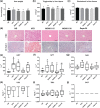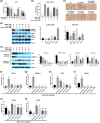Delayed intervention with a novel SGLT2 inhibitor NGI001 suppresses diet-induced metabolic dysfunction and non-alcoholic fatty liver disease in mice
- PMID: 31497874
- PMCID: PMC6989948
- DOI: 10.1111/bph.14859
Delayed intervention with a novel SGLT2 inhibitor NGI001 suppresses diet-induced metabolic dysfunction and non-alcoholic fatty liver disease in mice
Abstract
Background and purpose: Non-alcoholic fatty liver disease (NAFLD), including non-alcoholic steatohepatitis, is closely related to metabolic diseases such as obesity and diabetes. Despite an accumulating number of studies, no pharmacotherapy that targets NAFLD has received general approval for clinical use.
Experimental approach: Inhibition of the sodium-glucose cotransporter 2 (SGLT2) is a promising approach to treat diabetes, obesity, and associated metabolic disorders. In this study, we investigated the effect of a novel SGLT2 inhibitor, NGI001, on NAFLD and obesity-associated metabolic symptoms in high-fat diet (HFD)-induced obese mice.
Key results: Delayed intervention with NGI001 protected against body weight gain, hyperglycaemia, hyperlipidaemia, and hyperinsulinaemia, compared with HFD alone. Adipocyte hypertrophy was prevented by administering NGI001. NGI001 inhibited impaired glucose metabolism and regulated the secretion of adipokines associated with insulin resistance. In addition, NGI001 supplementation suppressed hepatic lipid accumulation and inflammation but had little effect on kidney function. In-depth investigations showed that NGI001 ameliorated fat deposition and increased AMPK phosphorylation, resulting in phosphorylation of its major downstream target, acetyl-CoA carboxylase, in human hepatocyte HuS-E/2 cells. This cascade ultimately led to the down-regulation of downstream fatty acid synthesis-related molecules and the up-regulation of downstream β oxidation-associated molecules. Surprisingly, NGI001 decreased gene and protein expression of SGLT1 and SGLT2 and glucose uptake in oleic acid-treated HuS-E/2 cells.
Conclusion and implications: Our findings suggest the novel SGLT2 inhibitor, NGI001 has therapeutic potential to attenuate or delay the onset of diet-induced metabolic diseases and NAFLD.
© 2019 The British Pharmacological Society.
Conflict of interest statement
The authors declare no conflicts of interest.
Figures







Similar articles
-
Ipragliflozin Improves Hepatic Steatosis in Obese Mice and Liver Dysfunction in Type 2 Diabetic Patients Irrespective of Body Weight Reduction.PLoS One. 2016 Mar 15;11(3):e0151511. doi: 10.1371/journal.pone.0151511. eCollection 2016. PLoS One. 2016. PMID: 26977813 Free PMC article.
-
Ugonin J improves metabolic disorder and ameliorates nonalcoholic fatty liver disease by regulating the AMPK/AKT signaling pathway.Pharmacol Res. 2021 Jan;163:105298. doi: 10.1016/j.phrs.2020.105298. Epub 2020 Nov 18. Pharmacol Res. 2021. PMID: 33220422
-
HCBP6 deficiency exacerbates glucose and lipid metabolism disorders in non-alcoholic fatty liver mice.Biomed Pharmacother. 2020 Sep;129:110347. doi: 10.1016/j.biopha.2020.110347. Epub 2020 Jun 11. Biomed Pharmacother. 2020. PMID: 32535386
-
SGLT2 Inhibitors as the Most Promising Influencers on the Outcome of Non-Alcoholic Fatty Liver Disease.Int J Mol Sci. 2022 Mar 27;23(7):3668. doi: 10.3390/ijms23073668. Int J Mol Sci. 2022. PMID: 35409028 Free PMC article. Review.
-
Effect of SGLT2 Inhibitors on Type 2 Diabetes Mellitus With Non-Alcoholic Fatty Liver Disease: A Meta-Analysis of Randomized Controlled Trials.Front Endocrinol (Lausanne). 2021 Jun 17;12:635556. doi: 10.3389/fendo.2021.635556. eCollection 2021. Front Endocrinol (Lausanne). 2021. PMID: 34220701 Free PMC article.
Cited by
-
The Intricate Relationship between Type 2 Diabetes Mellitus (T2DM), Insulin Resistance (IR), and Nonalcoholic Fatty Liver Disease (NAFLD).J Diabetes Res. 2020 Jul 31;2020:3920196. doi: 10.1155/2020/3920196. eCollection 2020. J Diabetes Res. 2020. PMID: 32832560 Free PMC article. Review.
-
Pathogenesis and Therapeutic Strategies Related to Non-Alcoholic Fatty Liver Disease.Int J Mol Sci. 2022 Jul 16;23(14):7841. doi: 10.3390/ijms23147841. Int J Mol Sci. 2022. PMID: 35887189 Free PMC article. Review.
-
Synbiotic Intervention with an Adlay-Based Prebiotic and Probiotics Improved Diet-Induced Metabolic Disturbance in Mice by Modulation of the Gut Microbiota.Nutrients. 2021 Sep 10;13(9):3161. doi: 10.3390/nu13093161. Nutrients. 2021. PMID: 34579036 Free PMC article.
-
Emergence of SGLT2 Inhibitors as Powerful Antioxidants in Human Diseases.Antioxidants (Basel). 2021 Jul 22;10(8):1166. doi: 10.3390/antiox10081166. Antioxidants (Basel). 2021. PMID: 34439414 Free PMC article. Review.
-
Development and validation of a nomogram diagnostic model for coronary slow flow patients: A cross-sectional study.Medicine (Baltimore). 2024 Nov 1;103(44):e40044. doi: 10.1097/MD.0000000000040044. Medicine (Baltimore). 2024. PMID: 39496058 Free PMC article.
References
-
- Alexander, S. P. H. , Roberts, R. E. , Broughton, B. R. S. , Sobey, C. G. , George, C. H. , Stanford, S. C. , … Ahluwalia, A. (2018). Goals and practicalities of immunoblotting and immunohistochemistry: A guide for submission to the British Journal of Pharmacology. British Journal of Pharmacology, 175, 407–411. 10.1111/bph.14112 - DOI - PMC - PubMed
Publication types
MeSH terms
Substances
Grants and funding
LinkOut - more resources
Full Text Sources
Medical

